Matador Network's Blog, page 894
March 30, 2020
Bread recipes, cookbooks, classes

Turns out a pandemic is a crash course in pantry cooking. Between limiting our trips to the grocery store and finding staple ingredients stripped from the shelves when we get there, self-isolation has become one long, inescapable episode of Chopped for many of us. But even Ted Allen can only do so much with canned chickpeas and that condiment that’s started fermenting in the back of the fridge. Fortunately, that’s not the case if you’re down to just flour.
Bread, one of the world’s most ubiquitous and universal foods, only requires a few ingredients that the average household may already have on hand. With ample time and patience, all you need is flour, water, and a pinch of salt. Start adding in extras like store-bought yeast, butter or oil, eggs, and the flavorings of your choosing, and the number of bread recipes you can pull off in your kitchen almost makes the idea of being stuck at home bearable.
If ever there was a time to master the art of the yeasted dough, it’s now. Here’s how to get started, from choosing the perfect first recipe to fermenting your own mother dough.
Try a time-honored recipe.

Photo: PV productions/Shutterstock
As with any new hobby, one of the first bread-baking challenges you’ll face is figuring out where to begin. In matters of the kitchen, that generally means choosing a trial recipe. For me, it was the cult-classic country loaf from San Francisco’s Tartine Bakery on the advice of my uncle, the most seasoned amateur bread baker I know. I’ve since added James Beard Award winner Jim Lahey’s no-knead bread to my list of recommendations, as well. It’s less ambitious for novice bakers as it neither requires a homemade starter nor any kneading, although the tradeoff is that the dough takes at least 12 hours to ferment. Alternatively, if you own a Dutch oven, brand notwithstanding, Le Creuset’s classic loaf recipe is tried, true, and exceptionally approachable.
Go cookbook shopping.
It’s astounding how quickly you can blow through bread recipes when you’re stuck indoors. If the hobby takes off after you’ve experimented with random recipes, take the plunge and build out your library. Both Jim Lahey and Chad Roberston of Tartine Bakery have written cookbooks that expand on their techniques and philosophies. Peter Reinhart’s The Bread Baker’s Apprentice, now in its 15th edition, has been converting home bakers into bread masters since 2001. Ken Forkish’s Flour, Water, Salt, Yeast joined the ranks of go-to guides in 2012.
Unlike individual recipes, investing in cookbooks provides an opportunity to dive deep into the world of dough. Accordingly, it’s a chance to learn from your favorite bread bakers. Always secretly wanted to audition for The Great British Bake Off? Work your way through the pages of Paul Hollywood’s Bread. Dreaming of eating your way through a French boulangerie? Transform your kitchen into a cuisine with the Poilâne cookbook from Paris’ first family of baking. The possibilities are as endless as your virtual shopping cart.
Start a starter.

Photo: Michael Kudela/Shutterstock
Behind every great sourdough loaf is a starter, a live culture made from flour and water that relies on wild yeast for leavening and its characteristic tang. The idea is simple: Combine flour, water, and time to kickstart fermentation, then feed your starter fresh flour and water to keep it alive. Regularly fed, it can survive in the refrigerator indefinitely. Just ask San Francisco’s Boudin Bakery, whose legendary mother dough is made with a 170-year-old yeast culture.
Rather than rely on a print recipe, which can be unclear if you have no point of reference for the finished product, consider a YouTube tutorial for visual cues as to whether or not your pre-ferment is successful. Matador staffer Morgane Croissant swears by Patrick Ryan’s masterclass, which takes you through the sourdough-making process from starter to loaf. I’ve found success following Joshua Weissman’s lead, with a little help from Pro Home Cooks.
At the end of the day, the most important ingredient in making a starter is time, of which many of us have an abundance of these days. Nonetheless, those uninterested in waiting a week before popping their first loaf into the oven can also order sourdough starter online.
Take advantage of tutorials and forums.
Among the most comprehensive resources for artisan bread bakers anywhere on the internet is Breadtopia, a digital forum that has everything from video tutorials and blog posts to recipes and an online store. It’s a one-stop shop for advice on the basics, including starters and no-knead recipes, as well as a place to share tips and tricks with other bakers. The Fresh Loaf is a similar concept with an active forum, books, lessons, recipes, and more that’s been met with equally rave reviews. If it’s finding a community of like-minded hobbyists you’re after, consider looking into the subreddits Breadit, ArtisanBread, and Sourdough.
Sign up for an e-class.
Of all the loaf-saving courses you can find online, none appear to be as widely recommended as Peter Reinhart’s artisan bread-baking class hosted by Bluprint, formerly Craftsy. A James Beard Award winner and instructor at Johnson & Wales University, Reinhart breaks the bread-baking process down into 12 steps and shares his techniques over more than five hours of lessons, all of which are available for free until April 9. Bluprint also hosts other online bread-baking courses, including several from always-reliable King Arthur Flour. Online learning platform Udemy has a variety of courses on offer, as well. 

More like this: This African country is a bread lover’s paradise
The post Now’s the time to get really good at baking bread appeared first on Matador Network.

March 27, 2020
Virtual field trips to take online

We’ve all been spending a lot of time at home lately, and for some, this new reality is tougher than others. After two weeks you may have already binged every Netflix show that piqued your interest and are desperately looking for new sources of entertainment — especially if you have kids. The Caroline County Public School District is trying to make it easier to entertain the whole family over the coming weeks and months by providing a thorough list of virtual field trips. While virtual excursions are never a truly satisfying replacement for the real thing, they can help keep boredom at bay and be a fun way of spending the afternoon with the young ones.
No matter where your interests lie, you’ll find a virtual excursion that works for you. For animal lovers, there are live cams at the San Diego Zoo, Monterey Bay Aquarium, Houston Zoo, Georgia Aquarium, and a panda cam at Zoo Atlanta. There’s also a virtual farm tour available for 11 different farms, featuring animals like cows, minks, and pigs.
Since outer space might be the only safe place to travel these days, the US Space and Rocket Museum in Huntsville, Alabama, is offering a look at the Saturn 5 rocket on YouTube, courtesy of a real father/son tour. To distance yourself even further from our planet, there’s a 360 WebVR experience centered around the Mars Curiosity Rover, in collaboration with the NASA Jet Propulsion Laboratory.
And if you’ve somehow got your kids to enjoy museums, there are even virtual field trips to iconic museums like The Louvre and Boston Children’s Museum, and monuments like the Great Wall of China. 

More like this: The best museums to visit virtually from your sofa, and what to look at
The post These virtual field trips will keep you busy during quarantine appeared first on Matador Network.

Angry Italian mayors

If the public health of your community wasn’t enough of an incentive to stay indoors during this pandemic, maybe mayors yelling at you and threatening you will do the trick. In Italy, Europe’s epicenter of the outbreak, where the lockdown has been in place the longest, mayors and governors around Italy went on TV to discourage people from breaking quarantine and socializing unnecessarily. And by “discourage people,” we mean “scare the living daylights out of people.”
Vincenzo De Luca, Governor of Campania, for example, said, “I’m getting word that someone is having a graduation party, we’ll send in the police. We’ll send them in with a flamethrower.”
Governor De Luca isn’t messing around.
Massimiliano Presciutti, Mayor of Gualdo Tadino, was similarly passionate. “But where the fuck are you going?” he said. “You go and queue up at the post office to recharge your phones, you go and queue up at the ATM machines? Where are you going with these incontinent dogs? You must stay at home!”
“These fucking hairdressers who go from home to home to fix women’s hair, what the fuck are they for?” said Antonio Tutolo, Mayor of Lucera. “What is the damn point? But do you understand that coffins are closed? Who will see all of these beautiful hairstyles in the coffins?”
And it’s not just Italy’s leaders getting frustrated. Mayor Gabe Brown of Walton, Kentucky, wrote on Facebook, “I pray every night that the State, County and region that I love with all of my heart will stop doing nonsensical things. Treat this seriously. If you don’t, then screw you (f#ck you is what I want to say, but I can’t).” 

More like this: 6 free or inexpensive apps and websites that make home-learning a breeze
The post Italian mayors are losing it and yelling at people for ignoring lockdown rules appeared first on Matador Network.

Disney+ Earth Month nature films

Earth Month might look a little different this year, considering most people around the world can’t exactly take advantage of the outdoors, but Disney+ is letting you experience the wilderness from the comfort of your living room. The streaming platform will be debuting two new documentary films on April 3, called Elephant and Dolphin Reef.
Disney+ will also release titles like In the Footsteps of Elephant and Diving with Dolphins, which will give viewers a peek into the behind-the-scenes process of the two films.
Elephant, narrated by Meghan, the Duchess of Sussex, follows the journey of an African elephant and her son as their herd journeys hundreds of miles across the Kalahari Desert. Dolphin Reef, narrated by Natalie Portman, focuses on a Pacific bottlenose dolphin named Echo, and the coral reef he calls home.
Beyond simply releasing films, Disney is also working closely with conservation efforts around the world. The Disney Conservation Fund is supporting Elephants Without Borders in Botswana to ensure that elephants are protected in their native environment. Grants from the Disney Conservation Fund have previously helped numerous non-profit organizations to save wildlife and the environment. 

More like this: 7 films you can stream on Disney+ that will inspire you to travel
The post Disney+ is releasing two new Disneynature films for Earth Month appeared first on Matador Network.

International LGBTQ films and TV

Let’s go on a gaycation. We can fall in love in Italy or have a San Francisco affair. We can don our best drag for an Australian road trip, or visit small-town America to shake up the local scene. If lounging by a lake in Provence is more your style, we can do that, too, though Miami’s waters are far warmer this time of year.
Better yet — let’s do it all. We don’t need a train, plane, or automobile to get there. As long as you’ve got a secure WiFi connection and a device that can stream content, the world is our oyster, because (plot twist!) we’re traveling from the comfort of our respective living rooms.
Movies and TV shows have the power to transport us to far-flung destinations, and in light of current events, there’s no better time to rely on their magic. If you’re reading this from home — be it due to self-isolation, quarantine, or sheltering in place — chances are you’re going a little stir-crazy. If that’s the case, these 12 LGBTQ stories provide an opportunity to escape the life within your four walls and explore the world, even if only for a few hours.
1. Priscilla, Queen of the Desert — Australia

Photo: IMDB
If your sedentary lifestyle is starting to weigh you down, consider taking a light-hearted road trip through the Australian Outback with the fabulous protagonists in Priscilla, Queen of the Desert. This 1994 film, a queer-cannon classic, follows the adventures of two drag queens and a trans woman as they drive a tour bus from the city of Sydney to a tiny town in the Northern Territory. The movie, which ends with a hike in full drag along the sandstone cliffs of King’s Canyon, is a visual travel brochure for Australia’s Red Centre.
2. Looking — San Francisco, California

Photo: IMDB
This HBO series, which aired in 2014 and ran for two seasons, follows a group of gay friends as they navigate life in one of the world’s greatest LGBTQ cities: San Francisco. On top of being an intimate snapshot of a particular queer community (mainly cis-gender white guys), the entire series is a love letter to Northern California’s Bay Area. Pretend you’re one of the boys as they canoe down the Russian River, explore their kinky side at Folsom Street Fair, or spend a sunny afternoon ogling boys on the “Gay Beach” section of Dolores Park. Watching Looking is like a free guided tour to all of San Francisco’s golden locations.
3. God’s Own Country — West Yorkshire, England

Photo: IMDB
Rooted in the rolling green hills and steely skies of West Yorkshire, God’s Own Country follows an unlikely gay love story between a local farmhand and a Romanian migrant worker. Much like Brokeback Mountain, which painted a romantic portrait of the Canadian Rockies where it was filmed, the sweeping cinematography in this 2017 film, directed by Francis Lee, turns the rough English countryside into poetry.
4. Pose — New York, New York

Photo: IMDB
Inspired by the 1990 documentary Paris is Burning, Ryan Murphy’s Pose takes a look at NYC ball culture in a tv series featuring queer black and brown performers often overlooked in mainstream media. It’s a veritable walking tour of the Big Apple, with stops at the Brooklyn Museum, the Ailey Studios, and neighborhoods like Red Hook and Washington Heights. While travel restrictions are currently keeping people from visiting these locations, nothing is stopping you from throwing your very own ball at home. Our suggestion: Live your best NYC fantasy and strut from your kitchen to your living room while serving some quarantine-couture realness. Eat your heart out, Billy Porter.
5. Pain and Glory — Valencia, Spain

Photo: IMDB
Spanish filmmaker Pedro Almodóvar’s 2019 film, a loosely autobiographical piece starring Oscar-nominated actor Antonio Banderas, is a psychological trip into the woes of an aging artist and a visual journey into the centers of Madrid and Valencia. Of particular note is Paterna, a municipality within Valencia famous for cave dwellings with chalk-white chimneys. Used as the filming location for the protagonist’s childhood home, the movie’s exploration of Paterna’s unique underground abodes thrust the area into the international spotlight. Although travel to Paterna is currently off-limits for most, nothing is stopping you from pressing play on Pain and Glory.
6. Call Me By Your Name — Lombardy, Italy
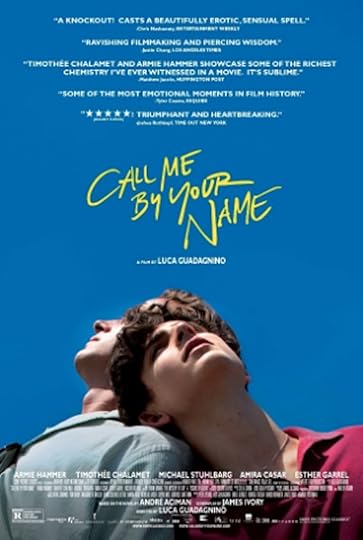
Photo: IMDB
In place of summer vacation plans, live vicariously through Elio and Oliver, the young lovers in Call Me By Your Name (2017) who spend a summer exploring the Italian countryside… and each other. Based on the novel by André Aciman, Call Me By Your Name was shot in the Lombardy region of Italy and is as much a sumptuous study of the country’s architecture and topography as it is of the two boys. Between the tiny town of Crema (an hour north of Milan), Bergamo’s ancient churches, Sermione’s idyllic lakeside ruins, and Cascate del Serio — Europe’s second-largest waterfall — the filming locations read like an Italian itinerary crafted by a local. With a handful of other painfully picturesque stops around the countryside, you may find yourself falling for Italy even harder than the two protagonists fall for each other.
7. American Crime Story: The Assassination of Gianni Versace — Miami, Florida

Photo: IMDB
It costs over $700 a night to stay at the former Versace Mansion on Miami’s Ocean Drive, but only the price of a Netflix subscription to take a digital tour while watching the 2018 TV series The Assassination of Gianni Versace. On top of showcasing the late Gianni Versace’s not-so-humble home (the pool features an intricate mosaic lined with 24-karat gold), Ryan Murphy’s drama takes viewers to Miami Beach’s queer hotspots, including a night at the long-lasting gay watering hole, Twist.
8. Transamerica — The United States

Photo: IMDB
When a preoperative trans woman named Bree (Felicity Huffman, who earned an Oscar nom for her performance), discovers she fathered a son who’s slumming it on the streets of NYC, she takes it upon herself to bring him back to her Los Angeles home. Together, the two embark on a road trip and come face-to-face with a diverse slice of American life. If that’s not enough to get you excited about this 2005 dramedy, you still have to listen to the film’s breakout song, “Travelin’ Thru.” This Dolly Parton bop is a necessary addition to any road-trip playlist.
9. Mamma Mia: Here We Go Again — Vis, Croatia

Photo: IMDB
This 2018 sequel to Mamma Mia, a jukebox movie musical featuring the sugar-pop songs of ABBA, is the Susan Sontag definition of camp: “It’s good because it’s awful.” Amanda Seyfriend (Mean Girls) gives a John Waters-sized performance, Colin Firth plays the gay dad we all wanted, and these three queens all make appearances — Christine Baransky, Cher, and our Lord and Savior Meryl Streep. The cherry on top of this sweet treat is the filming location — an island just off Croatia’s Dalmatian Coast. Vis, a floating Elysium surrounded by glassy-green waters, is replete with 17-century Venetian architecture and enough charm to knock your pants off. Let’s hope you’re wearing a bathing suit underneath.
10. Stranger by the Lake — Provence, France

Photo: IMDB
Although this French erotic thriller probably isn’t the feel-good film you need in light of current events, it does happen to be shot around the Lake of Sainte-Croix in Provence. In the movie, this serene reservoir surrounded by scrubby forests is transformed into a nude beach known for gay cruising. Frank, a single gay man, searches the shores for a summer romance and finds what he’s looking for in a mysterious man named Michel. After a death occurs, all fingers are pointed at the two lovers. At its core, the film is a parable about the need for social distancing — an all-too-relatable tale for our times.
11. EastSiders — Los Angeles, California

Photo: IMDB
This web series picked up by Netflix explores the dysfunctional relationships between several Los Angeles-based queer couples. The show’s five seasons bring the two main characters, Cal and Thom, from hipster haunts in LA’s Silver Lake neighborhood to the streets of New York City, and even across the country in a vintage camper trailer. The show sometimes reads like a shticky CW drama for 20-something queer folks, which is to say it’s totally binge-worthy. Regardless of the low-brow factor, EastSiders does a stalwart job grappling with modern-age monogamy and paints a diverse picture of Southern California’s LGBTQ landscape.
12. To Wong Foo, Thanks for Everything! Julie Newmar — United States

Photo: IMDB
Drag-fueled road trips are so much fun that this list needed two. To Wong Foo, Thanks for Everything! Julie Newmar — a 1995 cult classic starring Patrick Swayze, Wesley Snipes, and John Leguizamo — follows three drag queens who get stuck in a tiny town after their car breaks down between New York City and Los Angeles. Watching Swayze and his crew try to pass as biological women in a backward tumble-weed town is two hours of absolute escapism — the breath of fresh air we could all use right about now. 

More like this: The best LGBTQ events you can attend without leaving home
The post 12 LGBTQ films and TV shows to help you explore the world from your home appeared first on Matador Network.

Museums with the best online tours

As the COVID-19 outbreak forces the world to retreat indoors, museums and galleries are moving into the digital world to make sure their collections remain accessible to the public. The next few weeks or months of home quarantine needn’t be devoid of culture as, via the internet, art aficionados can now virtually visit collections and temporary exhibitions from the comfort of their homes.
Online access experiences can now take you from close-ups of Michelangelo’s Sistine Chapel ceiling in Rome to a five-hour marathon around the Hermitage Museum in St. Petersburg. Aside from a treat for the art enthusiast, these virtual tours might benefit parents looking to inject some culture into their children’s day, or those simply wanting to escape the constant barrage of news. Also, visiting museums has been proven to reduce stress levels, so this online access couldn’t come at a better time. Here are five of the best museums with digital resources.
1. The Louvre — Paris, France

Photo: Belyay/Shutterstock
The Louvre has digitized three tours of different parts of its galleries. The first tour takes visitors to see Egyptian Antiquities from the pharaonic period. The second tour allows you to explore the history of the building itself, the structure of which was once a fortress built by French king Philippe Auguste. In these two tours, a brief description of each room is provided and when you click on an exhibit, an information box appears with basic historical facts. As with Google street view, arrows show up on the ground which you can click to move into the next room.

Photo: Louvre
The final tour is focused on the recently restored Galerie d’Apollon. The long gallery houses 41 paintings, 118 sculptures, and 28 tapestries. Various interactive tools allow you to learn more about the most important exhibits.
What to look at:
Aside from the “Great Sphinx of Tanis” that greets visitors to the Egyptian Antiquities collection, highlights of the first tour include the intricately carved royal tomb of Ramesses III in Room 13, and Room 14, filled with lavishly decorated sarcophagi. During the second tour, you can see parts of the moat, defense walls, and piers that supported the drawbridge of the original fortress’ construction.

Photo: Isogood_patrick/Shutterstock
In the Galerie d’Apollon, make sure you look at the ceiling, a homage to King Louis XIV, that was started by his court painter Charles Le Brun. The middle panel depicts “Apollo Slaying the Serpent Python” by Eugène Delacroix, a French artist widely regarded as the leader of the French Romantic school.
2. Vatican Museums — Rome, Italy

Photo: Firat Cetin/Shutterstock
Though it could never be a substitute for the real thing, the Vatican’s 360-degree virtual tour of the Sistine Chapel lets you see the iconic interior as you never could in real life — crowd-free. You can explore the whole chapel and zoom in to get extraordinary details of Michelangelo’s frescoes.

Photo: Vatican Museums
You can similarly view Raphael’s frescoes up close in the 360-degree tour of the Raphael Rooms. Visitors can also move through various museums in the complex, such as the Pio Clementino Museum, packed with ancient sculptures.
As there is no floor plan provided, it is quite easy to get lost wandering through the rooms, but by visiting the information pages for the various museums and rooms, you can find videos that guide you to the most famous exhibits.
What to look at:

Photo: Creative Lab/Shutterstock
When in the Sistine Chapel, take advantage of the fact that you can see the ceiling close up, something hard to do in real life. Zoom in as far as you can on Michelangelo’s fresco of “The Creation of Adam,” the iconic moment where God touches the fingertip of Adam, to bring him to life, and on the monumental Last Judgement scene above the altar. Within the gory scenes of hell, seek out the flayed body of St. Bartholomew, whose face is a self-portrait of Michelangelo.
3. Thyssen-Bornemisza National Museum — Madrid, Spain

Photo: TK Kurikawa/Shutterstock
Some temporary exhibitions in progress or due to open in the near future have now been put online, including the Thyssen-Bornemisza National Museum’s “Rembrandt and Amsterdam Portraiture, 1590-1670” exhibition. You can now tour the entire exhibition virtually and view high-quality images of the paintings.

Photo: Thyssen-Bornemisza National Museum
Although there is no information on exhibits included in the virtual tour, you can also flick through an interactive publication about the exhibition and watch an introductory video.
The museum has similarly provided access to other past exhibitions in the form of video introductions and virtual tours. You can visit the “Balenciaga and Spanish paintings” collection and the “Dalí and Surrealism in the ABANCA Art Collection” exhibition.
What to look at:

Photo: izamon/Shutterstock
The intention of the Rembrandt exhibition is to place the 17th-century Dutch master in the context of his predecessors, his immediate competition in Amsterdam, and his followers. Try to follow the changing painting techniques and compositions throughout the rooms, reaching a climax with Rembrandt’s divergence from popular European style and move toward his characteristic rough brushwork and warm, dark tones. Don’t forget to look at Rembrandt’s etchings too.
4. Metropolitan Museum of Art — New York, USA

Photo: Studio Barcelona/Shutterstock
The Met has been developing a series of videos called the 360° Project which allows viewers to virtually visit different locations in its museums. The project concentrates particularly on giving viewers an unusual perspective on the gallery spaces.

Photo: Metropolitan Museum of Art
The videos transport you slowly through the various spaces and rooms, but you can simultaneously use your mouse or move your smartphone to get a 360-degree view at all times. If you really want to escape quarantine, there’s also the option of popping on a VR headset and being completely immersed.
What to look at:

Photo: Felix Lipov/Shutterstock
Watch the Met Cloisters video to take to the air and fly over the medieval-style buildings with views over the Hudson River and a soundtrack of chimes from the bell tower. In the video from the Met’s American Wing, you can peek over the shoulders of artists at work, and from the balcony, you can look down to see a timelapse of the crowd below. If you’re using a VR headset, don’t miss the fully immersive Temple of Dendur, dating from around 15 BCE, which captures the structure throughout the day, as the light from the vast glass windows of the gallery fades.
5. State Hermitage Museum — St. Petersburg, Russia

Photo: Yarygin/Shutterstock
If social distancing is beginning to take its toll, it might be the right moment to take your mind away to Russia with this five-hour long video through the rooms of the State Hermitage Museum. With slow cinematic music and moments of curious contemporary dance, it’s a powerful mental distraction.

Photo: State Hermitage Museum
The extraordinary video journeys through 45 galleries, features 588 masterpieces, and includes live music and ballet performances. On the museum’s website itself, there is also the option to take a virtual tour through the gallery complex.
What to look at:

Photo: Piith Hant/Shutterstock
As helpfully recommended by the YouTube video, highlights of the video tour include the grandiose, gilded Jordan Staircase in the Winter Palace and details of the Raphael Loggias, which were built as a reproduction of those found in the Papal Palace in Vatican City. The video takes you close up to individual artworks too, such as a self-portrait by Rembrandt and “The Lute Player” by Caravaggio, an Italian master from the late 16th and early 17th century. 

More like this: Cheerful books that will bring you joy during this isolating, scary time
The post The best museums to visit virtually from your sofa, and what to look at appeared first on Matador Network.

Why lilies associated with Easter

General Mills could make Easter-themed Lucky Charms with all the holiday’s symbols. The jingle practically rewrites itself: lamb, fish, and rabbits; pastel eggs in baskets; butterflies, palm branches; and some hot cross buns!
And then there’s the Easter lily.
Attend an Easter service anywhere in North America, and you’re bound to see white, trumpet-like flowers anchoring the floral arrangements, or at least pick up their strong perfume. Also known as Bermuda lilies, or Lilim longiflorum to the horticultural crowd, Easter lilies became the go-to flower for the spring holiday on American shores in the 20th century. Yet the lily’s ties to Christianity were established long before.
They’re mentioned in both the Old and New testaments of the Bible, referenced several times in the Song of Solomon as well as in the Sermon on the Mount. Legend has it that lilies also grew tall in the Garden of Gethsemane from the Agony of Christ.
They’re viewed as symbols of purity and rebirth. In ancient Egypt, water lilies represented creation and regeneration, innocence and modesty. According to Greek mythology, lilies were identified with the goddess Hera, who was believed to have created the flower from her milk.
Later, in the Christian faith, they became associated with the Virgin Mary, as well as the resurrection of Jesus, an event that’s commemorated every year on Easter.
Much as the lily’s significance has traveled through time and traditions, Easter lily bulbs have traversed the globe. Native to the Ryukyu Islands in southern Japan, the species was discovered by Swedish naturalist Carl Peter Thunberg in the late 18th century. Thunberg brought the lily to England, from where it later reached Bermuda in the mid-1800s.
Commercial production took off in Bermuda. By the turn of the century, the island nation was responsible for growing the majority of North America’s Easter lilies, though its streak only lasted a few decades. Production shuttered after a virus ravished the crop in the late 1800s, passing the bulk of the Easter lily market back over to Japan.
The flower’s commercial presence in the United States was forged by the World Wars. It’s credited with arriving on American soil in the suitcase of a World War I soldier named Louis Houghton upon his return to Oregon from Bermuda in 1919. Houghton, as the story goes, shared the seeds generously with friends and family.
It was not until World War II that production boomed in the United States, however. Following the events of Pearl Harbor, the Japanese Easter lily supply dried up, creating a domestic demand for the crop that caused its value to surge. It became known as “white gold” on the West Coast. By the war’s close in 1945, upward of 1,000 farmers had started cultivating the flower, finding particular success along the Oregon-California border.
Today, a slim, coastal stretch between the Harbor-Brookings and Smith River areas of Oregon’s Curry County and California’s Del Norte County, respectively, has come to be known as the “Easter Lily Capital of the World.” A wooden sign erected near the Smith River city limits announces as much to anyone passing through.
The industry has become more concentrated over the years, with just four commercial growers now producing all of the Easter Lily Capital’s bulbs. Their efforts not only account for the Easter lilies circulated around North America but are also commonly cited as representing 95 percent of the entire potted Easter lily market.
The majority of the bulbs grown in Smith River are sent to Canada, says Justin Riggs, the agricultural commissioner for Del Norte County, who notes that Puerto Rico also fills a large annual order. Other bulbs are sent to Europe, Asia, and elsewhere, where they’re forced into bloom in carefully controlled greenhouses.
It’s a fickle business, considering Easter falls on a different day every year. To ensure the flowers are ready in time for the holiday, their environments are strictly monitored. Temperature, moisture, and light are constantly regulated to ensure optimal growing conditions.

Photo: Kimberly Boyles/Shutterstock
It’s also a fickle flower that takes over two years to grow, though it’s suited to the West Coast.
“Long days and sunny summers are great for the crop,” explains Riggs. “Smith River specifically is warmer than other coastal parts of the county, and that really lets the bulbs get going.”
Along with Easter lilies, Del Norte County’s main agricultural industries are cattle, dairy, and timber. The county’s annual agricultural value is in the 40-60 million range, with lily bulb production accounting for 10 million of those dollars each year.
It’s a wide range. Timber production can fluctuate wildly, says Riggs, who also notes that, save for a small yet steady decline, the Easter lily demand is as stable as the holiday itself.
Yet, like so much else over the past few weeks, Easter is in jeopardy of being canceled this year, so to speak, due to the coronavirus crisis, much the way St. Patrick’s Day celebrations were impacted earlier this month. And as Easter gatherings go, so does the demand for Easter lilies, a concern growers are now working to reconcile.
It remains to be seen how the outbreak will affect the potted Easter lily industry in the post-COVID-19 world. But there’s always an alternative to buying your holiday blooms: growing them yourself. According to Riggs, who’s propagated them personally following commercial methods, Easter lilies are far more manageable in a home setting.
Just don’t expect them in time for Easter.
“They start breaking from the ground around the new year,” says Riggs. “Then, around here at least, they bloom naturally, if you don’t force them, right around the Fourth of July. And they’re really just the perfect thing to put around the flag.” 

More like this: The 7 most fascinating flowers around the world you need to see in person
The post The story behind your Easter lilies and the flower’s West Coast capital appeared first on Matador Network.

Tips for working from home with kids
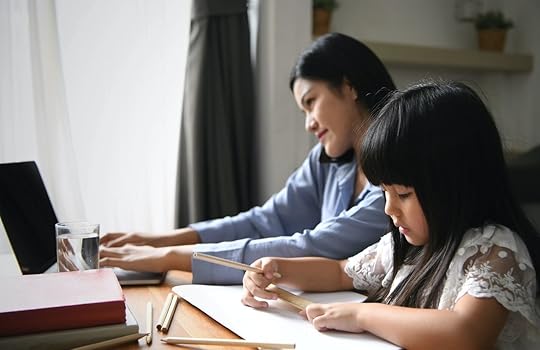
If you’re among the new legion of people working from home, you may be facing challenges that only weeks ago never would have crossed your mind. As someone who has headquartered in my home office for the better part of the last decade while also being a parent, I know well the unique demands of working from home. Adding kids into the mix just makes it tougher. Even people who usually work from home are stymied by the thought of homeschooling children while trying to keep their career afloat. Here are a few ideas to make the most of a tough situation.
Have some honest conversations.
Working from home has a lot of perks, daytime pajamas included. But it’s not a vacation. You still have to fulfill your obligations to clients and colleagues, and now also have kids looking to you for entertainment, education, and their own endless snack needs. It’s a good time to have some candid discussions about what you can and cannot feasibly do.
That starts with you taking an honest account of what you must do, what you would like to do, and what you are able to do. Then talk to the people this will affect. If you have a partner, now is a good time to figure out if the division of household chores and childcare duties you had before is still fair and workable, particularly if homeschooling is now a part of the mix. Discuss your expectations of each other and what you are hoping to accomplish at work.
Remember to keep your kids appraised of the situation. All the changes in their lives might be making them feel anxious, so the more information and structure you can provide, the better. If they are a bit older, bring them into the conversation. They might have some great ideas about how “the new normal” can work at your house.
Finally, keep the lines of communication open with your co-workers; this is all the more important if you are feeling overwhelmed right now. Perhaps a deadline is not quite as urgent as it was originally presented. Maybe you can cut back hours, or work at different times — such as before the kids wake up or after they go to bed. Fess up that you have kids at home who need you too and create a schedule that helps you balance that.
Create a schedule.
Working from home with kids in the house gives you the flexibility to get creative with the schedule. The reality is that when we work from home, we often don’t take the restful breaks we might actually take at work, say, for a meeting or a conversation with a colleague.
So at home, make lunch a time to spend together; that way, you won’t be tempted to work through your lunch break. Add an “after school” walk into your daily routine to ensure you and the kids get some fresh air and vitamin D (assuming you are still able to go outside, per your local guidelines — though even the strictest of lockdowns usually still allow for a short daily walk).
Posting a schedule that kids can refer to without needing to ask you “What’s next?” will help limit interruptions. You can even use pictures for pre-readers. If they know that “Mommy has to work in the morning but will play with me after lunch” they may be able to stave off some of their questions until later.
Also, know that saying “Go do something” to your kids while you are trying to get stuff done is not going to work. There are too many options and not enough direction to keep them occupied. Too much choice can be a killer. Depending on the age of your kids, they need a little (or a lot) more guidance. Consider making a list of things they could do, and post that list on the refrigerator.
You can explore Instagram timetables that range from the ridiculous to the sublime, with minute by minute agendas or unscheduled ideas. What will work best for your family depends on you and your kids, so try a few options as you settle into your new routine.
Help the kids be more self-sufficient.
Everyone is kind of feeling their way around what will work for them right now, kids included. As stressed as we are, our children are too. They have lost their social networks, daily structure, and regular extracurricular activities. Brainstorm together activities the kids can do on their own and set out the supplies they need to do them. Put some healthy snacks out in a place they can reach so they can help themselves if they feel hungry.
If their schools are doing online learning, make sure they know how to log on. If the teaching is being left up to you, there are a ton of homeschooling suggestions like Scholastic Learn at Home, and there are also several free or inexpensive home learning apps.
Fortunately, many companies have stepped up during the crisis and are streaming digital resources for free. You can help kids find a workout on YouTube, a free book on Audible, or a show on Amazon Prime with an Amazon account. You can find museums to tour virtually, and buy yourself some time while their little minds are expanding.
Set some parameters — for your kids and yourself.
Veteran work-from-homers know one of the toughest parts of working from home is setting boundaries. While there is usually more flexibility than at a “regular” office job, you still have deadlines and project goals to meet — so you’ll need to give the kids some ground rules. Examples that have worked for me and the other parents I spoke with include, “If I am on the phone, you may not interrupt.” Lest a child break your train of thought, a helpful one for writers, tell them that, “If my fingers are typing it means you may not talk to me.”
If you have an office, a closed door or a sticky note on the doorknob can be a good visual indicator that now is a time you can’t be disturbed. Additionally, set limits for yourself, too. When you work from home, there’s a temptation to work all the time. Go ahead and set hours for yourself to work, but also make sure you are setting times for breaks, and establish a quitting time when you will finish for the day. That’s when you need to close your laptop and give your kids your full focus.
Go easy on yourself.
These are unprecedented times and it is scary. Remember that we’re all just trying to do our best and right now that best might not look so hot. A lot of advice you will find centers on giving yourself space to relax. That’s admirable, but if you are relying on maintaining your work to provide your family’s income, the suggestion to take time off is frustrating and maybe even impossible. Likewise, the idea of letting your kids do their own thing for weeks on end can feel mildly negligent.
It will take some experimenting to find the right balance, but in the meantime, your usually high standards might need to loosen a bit. While you learn to work in new ways, your kids are going to gain some independence. See that as the good thing it is. When all this is said and done, you will be able to get back to business as usual. For now, have some compassion for your kids and for yourself. And it might help to recall that you aren’t alone. We’re all in this together. 

More like this: How people are coping with being far from family when borders are closed
The post Pro tips for working from home with kids in the house appeared first on Matador Network.

Positive environmental news
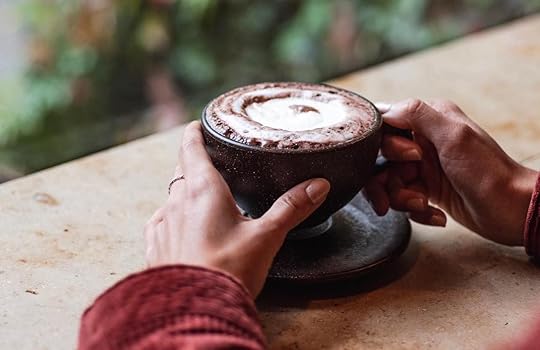
This is The Climate Win, the most positive sustainability news around the world every week.
Around the world, flight emissions have decreased, rush-hour congestion has thinned, and air is cleaner in major metro areas. Had we viewed this through a crystal ball three years ago, we might have guessed that it was the world finally taking its Paris Agreement commitments seriously. But unfortunately, it’s just the result of the sad-but-necessary practice of social distancing. Hopefully, as Time and others have recently opined, we as a society can adopt at least this one positive from a dire situation — that it is possible to see major progress when the entire world acts together to create systemic change. While we’re stuck indoors in the interim, we can address our own situations from within. This week, in lieu of stepping out into the world, The Climate Win looks at ways in which our everyday home lives can be less impactful.
TP with a conscience
We start with an idea that, had you thought of it merely two months ago, could have eliminated one of the most important items on your doomsday prep shopping list. Not only does Who Gives A Crap take our kudos for the best brand name ever, but it has also developed a tush-friendly product that is revolutionizing the way we produce and buy toilet paper. The company turns recycled paper into toilet paper, wraps it in zero-waste recyclable paper packaging, and ships it to your door (in a recyclable box). This means you avoid the plastic-wrapped toilet paper sold in stores and there’s no need to even wait on line only to find empty shelves. And, 50 percent of the company’s profits are dedicated to building toilets in countries where they’re needed most. It’s a win, from top to bottom.
Making disposable coffee cups biodegradable
As good as you may be at bringing your coffee thermos with you, there’s always that time when it gets left in the car or forgotten at home. A company in Berlin is working to make these little slip-ups less impactful on the environment by making to-go coffee cups out of used coffee grounds. Kaffeeform ships portable and at-home coffee mugs for drip coffee as well as espresso, lattes, and cappuccinos (it’s European, after all). This means you could stock an entire cabinet with coffee cups for a variety of purposes, each actually made from coffee. Even if you personally don’t do that, the idea is that maybe international coffee brands might, making cutting down trees to produce single-use coffee cups a thing of the past. If that doesn’t satisfy your caffeine fix, nothing will.
The way these products come to your door is evolving
A major issue with online ordering is the footprint necessary to deliver the product to the buyer’s home. This often produces more carbon emissions than if the buyer were to pick it up at a store — particularly if that buyer is shopping for multiple things on the same trip. A big chunk of those emissions may be wiped out in the coming years as fully electric semi-trucks make their way into our country’s shipping and logistics infrastructure. Big rig producer Freightliner recently introduced its eCascadia and eM 106 models, all-electric semis with enough power and torque to pull full-sized loads from port to port without a drop of diesel. The New York Times reported this week that big-name manufacturers including Volvo and Kenworth are also developing electronic big rig models, and while it’s going to be years before they replace most of the diesel versions on highways now, the long-term adoption of these new rigs could knock off up to eight percent of the country’s total CO2 emissions — an accomplishment even bigger than the trucks themselves.
Taking the waste out of online ordering
This week’s action task will help you reduce or eliminate what undoubtedly ends up in landfill every time you order something online: the plastic packaging and fillers. In your Amazon Prime account, open up a chat with a customer service representative. Ask the representative to leave a note on your account to avoid plastic packaging, and to use as little packaging as possible when plastic cannot be fully avoided. There is, as of this writing, no way to do this manually. You’ll have to ask through the instant messenger. Though ordering products from a faraway warehouse will never be more sustainable than buying locally sourced goods, this is at least a way to mitigate the damage. Hopefully, Amazon founder Jeff Bezos’ recent $10 billion commitment to fighting climate change leads his company toward a meeting with Freightliner. 

More like this: 5 community gardens that are setting an example in the United States
The post The Climate Win: reducing waste in the home and through online ordering appeared first on Matador Network.

History and how to eat Jamaican jerk

Almost everybody has heard of Jamaica’s most famous food: jerk. While jerk usually centers around a protein like chicken or pork, Jamaicans don’t stop there — they season veggies and fruits with jerk spice, too. Jerk is pungent, peppery, and spicy, so it often needs an accompaniment to take the edge off. Enter another beloved Jamaican food, this one being something that people unfamiliar with the island’s cuisine might not have heard about. Its name recalls the fun times one has when it’s served: festival bread, otherwise known as fried dough.
First and foremost, though, it’s important to understand what’s meant by “jerk.” There are a few theories about where the famous spice blend, made primarily with allspice and Scotch bonnet peppers, gets its name — and no, it has nothing to do with bad behavior. Some say it’s derived from how a cook turns the meat in a marinade, or how you can tear (or jerk) a strip from a larger piece of meat. Others say the English word is derived from the Peruvian term charqui, which means dried strips of meat. And indeed, charqui sounds a lot like the popular on-the-go snack, jerky.
Spice is an important part of jerk. There’s evidence that the indigenous Arawak people, who lived in both what we now called Peru and Jamaica, preserved meat in the jerk style of spicing and then smoking it. The Taíno indigenous people on the island also cooked this way, and specifically used the wood of allspice trees and flavor from allspice berries. The Maroons, enslaved Africans and their descendants in Jamaica, also cooked jerked meat, usually inside banana leaves. The Maroons typically added spices like hot peppers, thyme, and ginger.
Today, elements of these historic cooking traditions are seen in modern jerk with the addition of festival bread.
What is festival bread
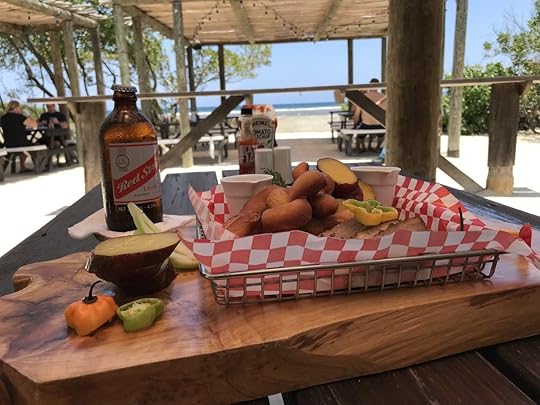
Photo: Johanna Read
No trip to Jamaica is complete without eating jerk. And to enjoy this dish properly, you should accompany it with festival bread.
Festival bread is a fried cornmeal bread with a touch of cinnamon and sugar. Festival somewhat resembles journey cakes (otherwise known as johnny cakes), which indigenous peoples of the Americas baked as sustenance during long journeys. Festival bread is also similar to hushpuppies from the American South.
“Jerk is deliciously spicy, so festival, which is a mix of cornmeal and all-purpose flour deep-fried in oil, helps to neutralize and counteract the spiciness as it starts to kick in,” explains Delroy Haye, the executive chef at Sandals Negril.
Festival rose in popularity in the 1970s, though no one is quite sure where it originated or where its name comes from. B.W. Highman, in his book Jamaican Food, writes that it “was named for the Jamaica Festival of Arts and Culture that marked annual Independence celebrations.” Haye adds that the dumplings “got their name because eating them was fun — like a festival, but in your mouth.”
“You can never buy just one festival,” Haye says. “It’s so simple but so addictive and cheap.” He recalls a childhood visit to Hellshire, a fishing town where local legend says the bread originated from, where he and his parents regularly indulged in festival as a side dish for larger meals. “My dad sent me to one of the stalls to buy some festival that we could eat with some other food we brought,” he says. “I brought my own money and got 10 festivals for myself because I love it that much.”
How to eat jerk meat and festival bread
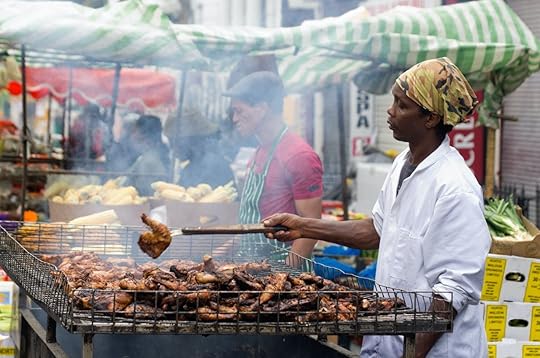
Photo: LongJon/Shutterstock
Festival bread, like jerk meat, can be eaten at festivals in Jamaica and at roadside shacks throughout the country. The best jerks are marinated overnight and then slow-cooked over pimento wood. Large sheets of zinc are put over the slowly cooking meat to trap the fragrant smoke.
The best festival to go with the meat, according to Haye, “is always freshly fried. It’s hot with just a little bit of oil on the outside, with a perfect golden brown color and a slightly sweet aroma and taste. It will have a nice crunch with each bite, but it’s still soft and doughy on the inside.”
To find the best food on your trip to Jamaica, Haye says to look for a line at the jerk shack. The best jerk shacks should have extra sauce on the counter for adding more kick. While there’s nearly always a spicy heat, the best jerk, he says, is balanced.
“Jerk is flavorful, smokey, and moist — not dry or too spicy where it takes away from the flavors,” he explains.
To counteract the spiciness of jerk, Chef Haye advises sipping Ting, Jamaican grapefruit soda, in between bites. He adds “don’t forget to eat a piece of festival after each bite of jerk chicken or pork “to keep the fire at bay.” 

More like this: How to eat and drink your way through Grenada, the Caribbean’s most flavorful island
The post Jamaica’s jerk and festival bread is the ultimate Caribbean pairing appeared first on Matador Network.

Matador Network's Blog
- Matador Network's profile
- 6 followers



